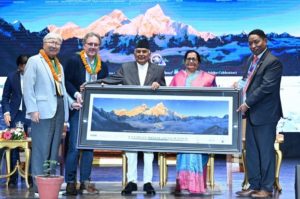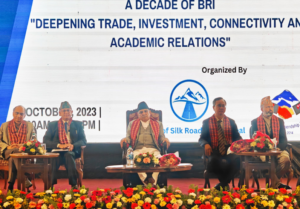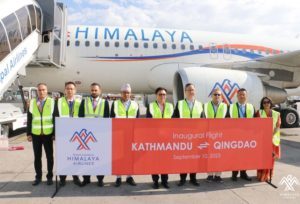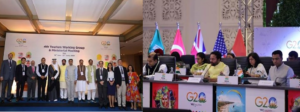Nepal and China celebrate Diamond Jubilee of diplomatic ties, exchange greetings
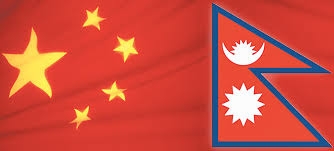
By Ramesh Tiwari / TravelBizNews—
Kathmandu: Nepal and China are celebrating diamond jubilee of establishment of diplomatic relations by organizing various events in both the countries this year.
Both the countries of Asia had established diplomatic relations on August 1, 1955.
On the occasion of 60th anniversary of diplomatic relations, Nepali and Chinese head of states, governments and people representing various non- governmental organizations have exchanged greetings of continued friendship and cooperation.
President of Nepal Dr. Ram Baran Yadav and President of the People’s Republic of China Xi Jinping have exchanged congratulatory messages on the occasion of the 60th anniversary of the establishment of diplomatic relations between Nepal and the People’s Republic of China.
President Yadav has stated that the five principles of peaceful co-existence provide a strong foundation of bilateral relationship, and Nepal respects one China policy.“ Nepalese people hold the Chinese people in high esteem as true and trusted friend, and this has found the best expression during the devastating earthquake that struck Nepal recently. “

While expressing happiness over China’s impressive socio-economic progress over the last six decades, President expressed best wishes for continued progress and prosperity of the friendly people of China.
Similarly, President of the People’s Republic of China Xi Jinping extended warm greetings and best wishes to the Government and the people of Nepal.“China and Nepal are good neighbours, friends and partners. The bilateral relations have steadily developed over past sixty years and the comprehensive cooperative partnership featuring ever-lasting friendship has been established.”
President Xi attached great importance to development of China-Nepal relations and expressed readiness to work for more fruitful results benefitting both countries and people.
Likewise, Prime Minister of Nepal Sushil Koirala and Premier of the State Council of the People’s Republic of China Li Keqiang have exchanged congratulatory messages on the occasion.
‘Nepal-China relations have been nurtured, strengthened and consolidated by mutual respect, understanding, trust and friendship for mutual benefit. Nepal and China remain ideal neighbours and have been working closely on issues of common interests at regional and international forums. China is Nepal’s trustworthy neighbour, an intimate friend and a reliable development partner. Nepal remains committed to “One China Policy” and do not allow any hostile activities on its soil against its neighbours. We appreciate Chinese assistance in its development efforts, humanitarian support in the aftermath of Nepal’s earthquake and commitment to substantial support to Nepal’s reconstruction and rebuilding,’ the Prime Minister stated.
Li Keqiang, Premier of the State Council of the People’s Republic of China, in his message stated that China and Nepal have always developed relationships on the basis of Five Principles of Peaceful Co-existence and have set a good example in building equal and friendly relations between small and large neighbours.
Premier Li added that the Chinese side consistently supports the efforts of Nepali people in maintaining independence, sovereignty and territorial integrity and highly appreciated Nepal’s adherence to one-China policy, according to a release of Ministry of Foreign Affairs of Nepal.He expressed commitment to continuously upgrading China-Nepal comprehensive cooperative partnership featuring ever-lasting friendship to a higher level.
Nepal and China enjoy a long history of exchanges dating back to over a millennium ago. A Chinese monk Faxian of the Eastern Jin Dynasty (317-420) and Xuanzang of the Tang Dynasty (618-907) visited southern Nepal to acquire Buddhist scriptures, while an outstanding Nepalese artisan Arniko visited China during the Yuan Dynasty (1206-1368) built the delicate and charming White Stupa in central Beijing, still an attractive scenic spot in the Chinese capital Beijing according to Xinhua.
Chinese President Jiang Zemin, Chinese Premier Zhu Rongji , Premier Wen Jiabao and other high officials have visited Nepal during the last two decades.

Nepal and China agree that the diplomatic relations established in 1955 and characterized by equality, harmonious co-existence, ever-lasting friendship and comprehensive cooperation, are of great importance to both nations.Both the countries have committed to promote friendly relations of Comprehensive Partnership of Cooperation Featuring Ever-Lasting Friendship on the basis of the Five Principles of Peaceful Coexistence in recent years.
The two countries have strengthened cooperation in socio-economic development, trade , tourism, hydropower, transportation infrastructure development, and other sectors on the basis of equality and mutual benefit.
Nepal is a founding member of the Asian Infrastructure Investment Bank and participated in the Silk Road Economic Belt project.
Chinese President Xi Jinping welcomed Nepal in the Belt and Road cooperation during meeting with Nepalese President in 2015 Boao Forum for Asia (BFA) in South China’s Hainan Province in March ,2015.
Nepal is one of the popular destinations for Chinese visiting overseas. The Chinese government granted Approved Destination Status (ADS) to Nepal in November 2001, allowing Chinese travellers to visit South Asian neighbor Nepal. A total of 123,805 Chinese tourists visited Nepal in 2014.
Meanwhile, Nepal has received substantial pledges from China for earthquake reconstruction. Foreign Minister of China Wang Yi, at the International Donor Conference on Nepal’s Reconstruction on June 25, 2015 pledged three billion RMB Yuan of grant assistance between 2016 and 2018, in five major areas,namely, infrastructure, livelihood for people living in mountains, cultural relic renovation, disaster preparedness, and health among others.
Chinese Foreign Minister Wang Yi announced to increase China’s annual grant assistance to Nepal to 800 million Yuan from 150 million Yuan during his visit to Nepal in 2014.
Nepal and China have planned several activities and programs to mark diamond jubilee of establishment of diplomatic ties throughout the year 2015.
August 1, 2015


